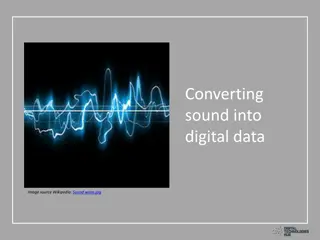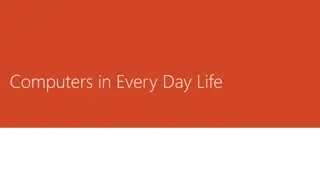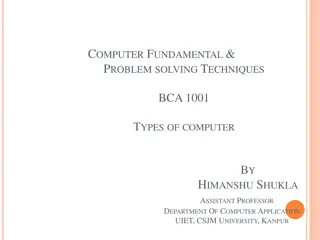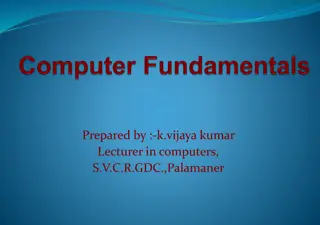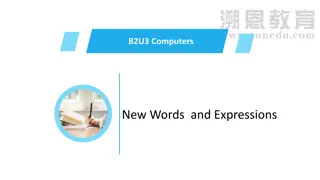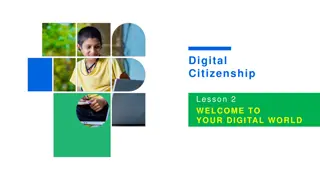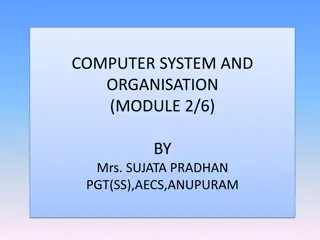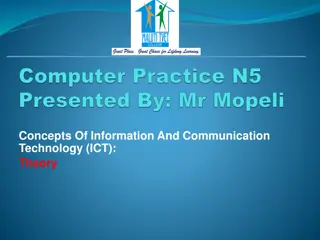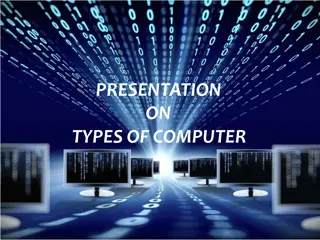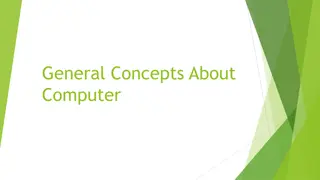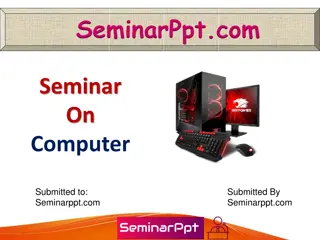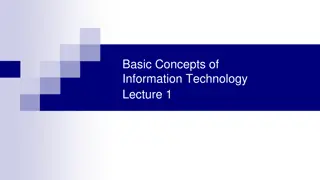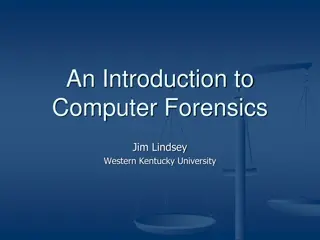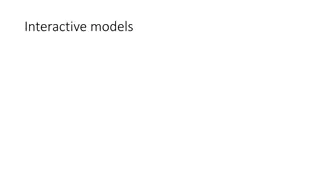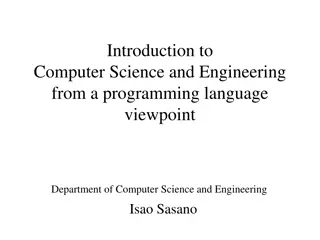Introduction to Discovering Computers: Your Interactive Guide to the Digital World
Delve into the world of computers with "Discovering Computers 2012," exploring basic concepts such as the definition of a computer, its components, importance of computer literacy, and the role of computers in various sectors. Discover the distinctions between system and application software, types of computers, and how different users interact with technology. Uncover the ubiquitous presence of computers in our daily lives and understand the fundamental components that make up a computer system.
Download Presentation

Please find below an Image/Link to download the presentation.
The content on the website is provided AS IS for your information and personal use only. It may not be sold, licensed, or shared on other websites without obtaining consent from the author.If you encounter any issues during the download, it is possible that the publisher has removed the file from their server.
You are allowed to download the files provided on this website for personal or commercial use, subject to the condition that they are used lawfully. All files are the property of their respective owners.
The content on the website is provided AS IS for your information and personal use only. It may not be sold, licensed, or shared on other websites without obtaining consent from the author.
E N D
Presentation Transcript
Discovering Computers 2012 Your Interactive Guide to the Digital World
Text and Reference Books 2 Discovering Computers 2011: Living in a Digital World Chapter 1
Objectives Overview Define the term, computer, and describe the relationship between data and information Explain why computer literacy is vital to success in today s world Describe the five components of a computer Discuss the advantages and disadvantages that users experience when working with computers Define the term, network, and identify benefits of sharing resources on a network Discuss the uses of the Internet and World Wide Web See Page 3 for Detailed Objectives Discovering Computers 2012: Chapter 1 3
Objectives Overview Distinguish between system software and application software Differentiate among types, sizes, and functions of computers in each category Describe the role of each element in an information system Explain how home users, small office/home office users, mobile users, power users, and enterprise users each interact with computers Discuss how society uses computers in education, finance, government, health care, science, publishing, travel, and manufacturing See Page 3 for Detailed Objectives Discovering Computers 2012: Chapter 1 4
A World of Computers Computers are everywhere Pages 4 - 5 Figure 1-1 Discovering Computers 2012: Chapter 1 5
What Is a Computer? A computer is an electronic device, operating under the control of instructions stored in its own memory Collects data (input) Produces information (output) Processing Information Processing Cycle Page 6 Discovering Computers 2012: Chapter 1 6
What Is a Computer? Page 6 Figure 1-2 Discovering Computers 2012: Chapter 1 7
The Components of a Computer A computer contains many electric, electronic, and mechanical components known as hardware Input Device Allows you to enter data and instructions into a computer Output Device Hardware component that conveys information to one or more people Case that contains the electronic components of the computer that are used to process data System Unit Records (writes) and/or retrieves (reads) items to and from storage media Storage Device Communications Device Enables a computer to send and receive data, instructions, and information to and from one or more computers or mobile devices Pages 6 - 8 Discovering Computers 2012: Chapter 1 8
The Components of a Computer Page 7 Figure 1-3 Discovering Computers 2012: Chapter 1 9
Advantages and Disadvantages of Using Computers Advantages of Using Computers Disadvantages of Using Computers Speed Health Risks Reliability Violation of Privacy Consistency Public Safety Storage Impact on Labor Force Communications Impact on Environment Pages 9 - 10 Discovering Computers 2012: Chapter 1 10
Advantages and Disadvantages of Using Computers Green computing involves reducing the electricity consumed and environmental waste generated when using a computer Strategies include: Recycling Regulating manufacturing processes Extending the life of computers Immediately donating or properly disposing of replaced computers Page 10 Discovering Computers 2012: Chapter 1 11
Networks and the Internet A network is a collection of computers and devices connected together, often wirelessly, via communications devices and transmission media Pages 10 - 11 Figure 1-6 Discovering Computers 2012: Chapter 1 12
Networks and the Internet The Internet is a worldwide collection of networks that connects millions of businesses, government agencies, educational institutions, and individuals Page 11 Figure 1-7 Discovering Computers 2012: Chapter 1 13
Networks and the Internet People use the Internet for a variety of reasons: Communicate Research and Access Information Shop Bank and Invest Online Trading Entertainment Download Videos Share Information Web Application Pages 12 - 13 Figure 1-8 Discovering Computers 2012: Chapter 1 14
Networks and the Internet A social networking Web site encourages members to share their interests, ideas, stories, photos, music, and videos with other registered users Page 14 Figure 1-9 Discovering Computers 2012: Chapter 1 15
Computer Software Software, also called a program, tells the computer what tasks to perform and how to perform them System Software Operating system Utility program Application Software Pages 15 - 16 Figures 1-10 - 1-11 Discovering Computers 2012: Chapter 1 16
Computer Software Installing is the process of setting up software to work with the computer, printer, and other hardware Pages 16 - 17 Figure 1-12 Discovering Computers 2012: Chapter 1 17
Computer Software A programmer develops software or writes the instructions that direct the computer to process data into information Page 18 Figure 1-13 Discovering Computers 2012: Chapter 1 18
Categories of Computers Personal computers Mobile computers and mobile devices Game consoles Servers Mainframes Supercomputers Embedded computers Page 19 Discovering Computers 2012: Chapter 1 19
Personal Computers A personal computer can perform all of its input, processing, output, and storage activities by itself Two popular architectures are the PC and the Apple Desktop computer Pages 19 - 20 Figures 1-15 - 1-16 Discovering Computers 2012: Chapter 1 20
Mobile Computers and Mobile Devices Mobile Computer Mobile Device Personal computer you can carry from place to place Computing device small enough to hold in your hand Examples include smart phones and PDAs, e- book readers, handheld computers, portable media players, and digital cameras Examples include notebook computers, laptop computers, netbooks, ultra-thins, and Tablet PCs Pages 20 - 23 Discovering Computers 2012: Chapter 1 21
Mobile Computers and Mobile Devices Notebook computer Tablet PC Smart phones and PDAs E-book reader Pages 20 - 22 Figures 1-17 1-20 Discovering Computers 2012: Chapter 1 22
Mobile Computers and Mobile Devices Handheld computer Portable media player Digital camera Pages 22 - 23 Figures 1-21 1-23 Discovering Computers 2012: Chapter 1 23
Game Consoles A game console is a mobile computing device designed for single-player or multiplayer video games Page 24 Figure 1-24 Discovering Computers 2012: Chapter 1 24
Servers A server controls access to the hardware, software, and other resources on a network Provides a centralized storage area for programs, data, and information Page 25 Figure 1-25 Discovering Computers 2012: Chapter 1 25
Mainframes A mainframe is a large, expensive, powerful computer that can handle hundreds or thousands of connected users simultaneously Page 25 Figure 1-26 Discovering Computers 2012: Chapter 1 26
Supercomputers A supercomputer is the fastest, most powerful computer Fastest supercomputers are capable of processing more than one quadrillion instructions in a single second Page 25 Figure 1-27 Discovering Computers 2012: Chapter 1 27
Embedded Computers An embedded computer is a special-purpose computer that functions as a component in a larger product Consumer Electronics Home Automation Devices Process Controllers and Robotics Computer Devices and Office Machines Automobiles Mobile and digital telephones Digital televisions Cameras Video recorders DVD players and recorders Answering machines Thermostats Sprinkling systems Security monitoring systems Appliances Lights Antilock brakes Engine control modules Airbag controller Cruise control Remote monitoring systems Power monitors Machine controllers Medical devices Keyboards Printers Faxes Copiers Page 26 Discovering Computers 2012: Chapter 1 28
Embedded Computers Page 26 Figure 1-28 Discovering Computers 2012: Chapter 1 29
Elements of an Information System Hardware Software Data People Procedures Page 27 Discovering Computers 2012: Chapter 1 30
Elements of an Information System Page 27 Figure 1-29 Discovering Computers 2012: Chapter 1 31
Examples of Computer Usage Home User Small Office/Home Office User Mobile User Personal financial management Web access Communications Entertainment Connect to other computers on a network or the Internet Transfer information Play video games Listen to music Watch movies Look up information Send and receive e-mail messages Make telephone calls Pages 28 31 Figures 1-30 1-32 Discovering Computers 2012: Chapter 1 32
Examples of Computer Usage Power User Enterprise User Work with multimedia Use industry-specific software Communicate among employees Process high volumes of transactions Blog Pages 31 32 Figures 1-33 1-34 Discovering Computers 2012: Chapter 1 33
Computer Applications in Society Education Finance Government Health Care Pages 34 - 36 Figures 1-36 1-39 Discovering Computers 2012: Chapter 1 34
Computer Applications in Society Science Publishing Travel Manufacturing Pages 36 - 38 Figures 1-40 1-43 Discovering Computers 2012: Chapter 1 35
Video: Computer History in a Barn CLICK TO VISIT Discovering Computers 2012: Chapter 1 36
Summary Basic computer concepts Components of a computer Many different categories of computers, computer users, and computer applications in society Networks, the Internet, and computer software Page 39 Discovering Computers 2012: Chapter 1 37
Discovering Computers 2012 Your Interactive Guide to the Digital World Chapter 1 Complete
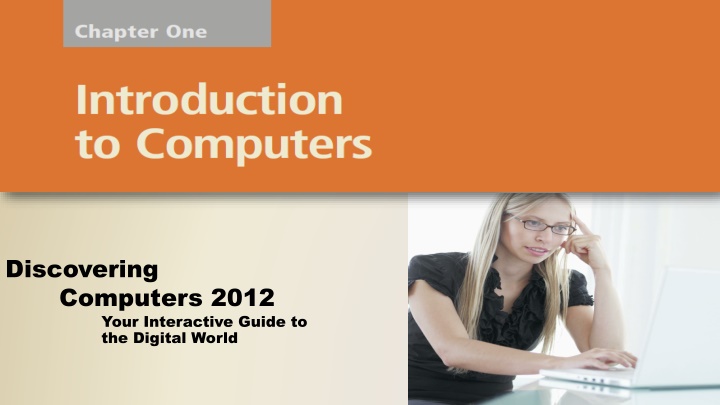

![[PDF READ ONLINE] LAS VEGAS TRAVEL GUIDE 2023: DISCOVERING THE EXCITEMENT AND BE](/thumb/2060/pdf-read-online-las-vegas-travel-guide-2023-discovering-the-excitement-and-be.jpg)


